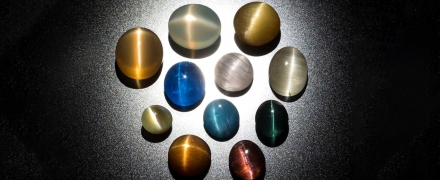open 10 am - 7 pm
laboratory is closed
"Eyed" stones

Stones with an "eye" texture pattern or with a "cat's eye" effect have been valued since ancient times as amulets against evil spirits, diseases, the evil eye and other troubles and were in demand among many peoples as talismans of everyday wear. The explanation for this apparently lies in the fact that many animals do not like a gaze directed at themselves. Most often, agates, jaspers, flints with a corresponding pattern were used for the purposes of the amulet, but any other stones and rocks in which an "eye" pattern was observed in the local area could also be used. However, preference was still given to agate. A little later, glasses with an eye-like pattern were widely used in the form of amulets, due to a special mixture of types of glasses of different colors. Such types of inserts can still be found in abundance in jewelry made in the Mediterranean and Middle Asian regions. The most highly valued products are those with a "eye" resembling a cat's eye - these are agates with a lenticular "eye" or a narrow contrasting stripe, as well as jasper and flint with a similar pattern. The most rare were translucent and translucent stones with iridescence in the form of a "cat's eye", and transparent stones with such an effect were the lot of selected influential persons. In addition to the use of stones with the "cat's eye" effect in jewelry, they were also often adorned with armor and weapons, home clothes and, especially, outfits for going out.
В геммологической практике бывают весьма увлекательные случаи с диагностикой ювелирных вставок
Но помимо редкости цвета и высокой стоимости таких камней, многие розовые камни выделяются одной замечательной особенностью – они проявляют плеохроизм, то есть в зависимости от положения осмотра камня он может иметь дополнительные оттенки – оранжевый или пурпурный.
Currently, gemstones are produced by two fundamentally different technological methods - the High Pressure - High Temperature method (“HPHT”, High-pressure & High-temperature) and the Chemical Vapor Deposition (“CVD”, Chemical vapor deposition) method. The "HPHT" method is the most tested classical synthesis method, which can be used both carbon deposition on diamond from flux melts and catalytic reactions. In "CVD" synthesis, diamond growth occurs on a seed during carbon deposition mainly from a gaseous medium at relatively low temperatures and pressures.
Jewelry and precious stones are just such a category of goods, when buying which you need to pay attention to many criteria.
Sogdianite is a rather rare mineral and more often it can be found as a collection material (moreover, in systematic collections), and it is extremely rare in jewelry.






